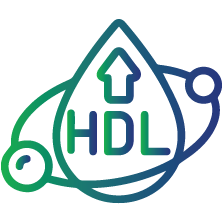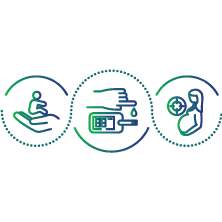
Blood Glucose Postprandial (PPBS)
About Glucose Post-Prandial Test
A post-prandial blood glucose test, also known as a glucose post-prandial test, is a common test performed to determine sugar levels in an individual two hours after eating their meal. This test is used to monitor individuals with pre-diabetes and diabetes (Type 1 and 2). It helps to understand how the body reacts to consuming sugars and carbohydrates after a meal. If the blood glucose levels do not return to normal within two hours of eating, this could be an indication that one has diabetes.
This test is recommended by the healthcare providers to screen, monitor, and diagnose the risk of developing diabetes
This test is also known as
Glucose, postprandial; glucose, 2-hour postprandial; 2-hour PPG; 2-hour postprandial blood sugar.
Symptoms of Diabetes

Feeling thirsty very often

Feeling hungry often

Fatigue

Urinating a lot

Losing weight without efforts

Numbing or tingling of hands and feet

Slow healing of any cuts or wounds

Having infections more than usual

Dry skin

Blurred vision
Who should get tested?

Age over 35 years

Overweight or obese

Family history of diabetes

High cholesterol

High Blood Pressure

Heart diseases

Gestational diabetes

Polycystic Ovarian Syndrome (PCOS)
Test preparation
No special preparation is required to take glucose post-prandial blood test. For accurate postprandial blood glucose testing, it is essential to consume a standard meal before the test. This helps assess how your body processes glucose after eating. Follow your healthcare provider's instructions on the type and timing of the meal before the test
Interpretation of the Test Results
The units of measurement for the results are milligrams per decilitre
|
Indication |
Blood ranges (mg/dL) |
|
Normal |
140 and below |
|
Pre-diabetic |
140 - 199 |
|
Diabetic |
200 and above |
Deviations from normal ranges
Your results may indicate you have diabetes or are at risk of developing it if they show higher than normal glucose levels. In addition, high glucose levels could indicate:
· Hyperthyroidism
· Pancreatic disorders
· Stress following surgery, a life-threatening illness, or trauma
Chronically elevated levels of sugar in blood may be indicative of diabetic-related complications such as vision impairment, hypertension, obesity, heart diseases, etc
FAQs
What is the turnaround time (TAT) for Glucose post-prandial plasma test?
The glucose post-prandial plasma test results are usually available within the same working day after sample collection
Are there any risks associated with glucose post-prandial plasma test?
No, there are absolutely no risks related to Glucose post-prandial plasma test. It is a simple test with no associated risks
What is the procedure involved in sample collection of glucose post -prandial plasma test?
Your healthcare provider will insert a small needle into a vein in your upper arm and collect a few mL of blood. It might cause a feeling of slight sting or a bruise at the site of needle insertion. It usually resolves within a few minutes to a couple of hours
What affects the glucose post-prandial plasma test?
Excess sugary diet before the test, smoking, stress, etc., are a few factors that could affect the test results of the Glucose post prandial plasma test
What are the best foods to lower my blood sugar?
A meal plan must be tailored according to an individual's specific needs. Testing your glucose levels at different times of the day will show you how your foods are affecting your levels. Eat high fibre foods, drink lots of water, and focus on eating veggies, legumes, and fish

